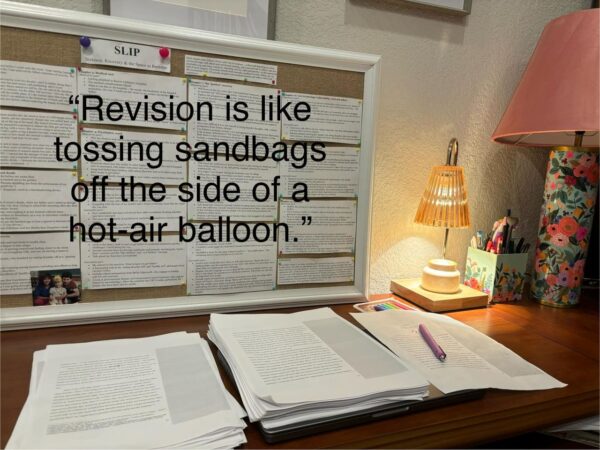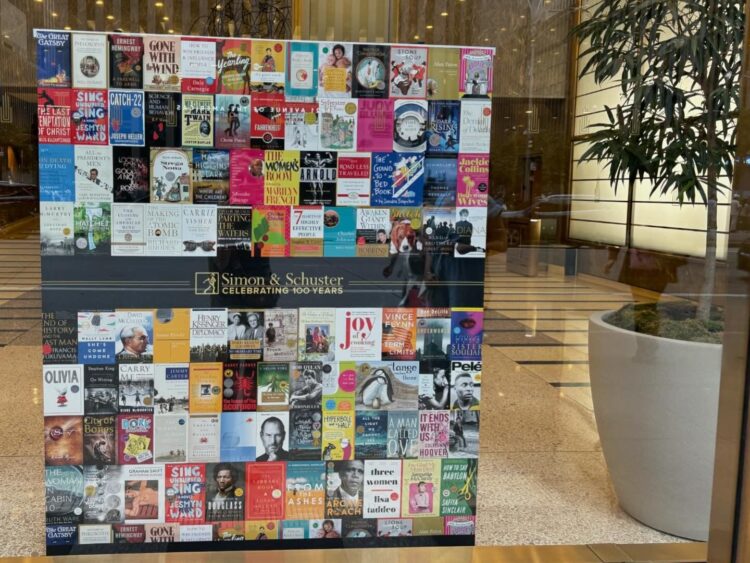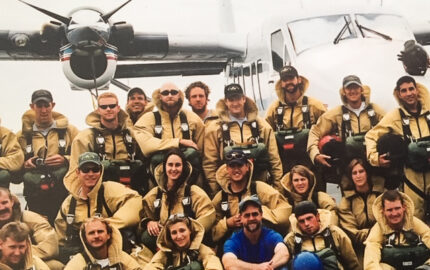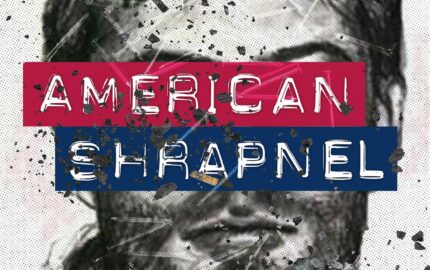As a first-time author, I’ve spent the past four years writing and reporting my debut nonfiction book, “SLIP: Life in the Middle of Eating Disorder Recovery.” It’s been such a long labor of love that some acquaintances have asked: “Wait, is this your second book, or are you still working on your first one?”
I understand why they ask; most people don’t know all that goes into landing a nonfiction book deal with a Big Five publisher. Sometimes, I give them the abbreviated version of how the process works, with the caveat that it plays out a bit differently for everyone. Here’s a quick overview of how it worked for me, followed by a special focus on what still needs to happen after you send in a complete manuscript:
Maybe you decide to self-publish. If not, you need to query literary agents, whose job is to sell your book to a publisher. If you’re lucky enough to sign with an agent and you haven’t already written a proposal, you write one with help from your agent. These are lengthy documents; mine was 85 pages. Your agent shops that proposal to various publishers — a submission process that can take weeks, months, sometimes years. Amid the rejections, you hope for a yes.
After a tremendous amount of work, I got my own yes from a Simon & Schuster imprint in December 2022. By that point, I had been working on “SLIP” for about two years, exploring ways to convey the nuances of eating disorder recovery through a mix of personal narrative, research and cutting-edge science. Once I signed my contract, I had 18 months to complete my reporting and writing.
I finished my manuscript in early June, but the work is far from done. I spent the summer in back-and-forths with my editor to fine-tune the final draft. Being at this stage feels like completing the last few miles of an ultra-marathon: It’s both exhausting and energizing; it requires the humility to accept most edits and the confidence to speak up when you disagree with others; it demands time, undivided attention and an openness to change — all in service of making your book as good as it can be before it goes out into the world.
Along the way, I’ve kept note of some related takeaways that have helped me through this last editing stage.
Prepare for Tough Love
During the month in between turning in my manuscript and receiving edits, I wrestled with inevitable questions: Will my editor like what I wrote? Will her edits be minimal, extensive or somewhere in between? What if some chapters still need a lot of work? It’s one thing to rework an 800-word story; it’s another thing entirely to have to potentially rework a 100,000-word manuscript.
Instead of wallowing in uncertainty, I reminded myself of a quote from journalist and author Anne Hull. “Reviewing a draft with my editor is a tough-love session,” she’s quoted as saying in the book “Telling True Stories.” “I don’t want to be loved unconditionally; I want to understand what’s wrong with my draft so I can improve it.”
I wrote that quote on a Post-it note and hung it in my home office as a reminder of what the editing process is all about. It’s not about expecting perfection from yourself; it’s about pushing yourself to be better, with your editor’s help.
Do a Curiosity Read
I’m the type of writer who loves being edited. I admittedly winced, though, when I first scrolled through my editor’s many comments and questions in the margins of my manuscript. At this point, my book was like my third child, and I could feel myself being overly protective of it.
Not wanting to address the edits from a defensive stance, I decided to set the manuscript aside. I reflected on the edits, then revisited them a couple days later to do what I call a “curiosity read,” approaching them from a place of inquiry rather than defensiveness. I considered: What kinds of questions is my editor asking? What can I learn from her comments? How do her edits improve the overall writing?
In asking these questions, I could read the edits with an open mind and an appreciation for how helpful they were. I also could see that the notes were more complimentary than critical and that they weren’t going to require a heavy lift on my part. In a follow-up conversation with my editor, I came to understand her edits even better. Open communication is so key during this final stage of editing, and it helps move the process forward.
Create an Outtakes Document
The British writer Sir Arthur Quiller-Couch once famously advised writers to “murder your darlings.” By that, he of course meant that writers should be willing to part with passages they like, especially if an editor says they’re not working.
I have long appreciated this maxim, but instead of murdering my darlings, I send them to my outtakes document. This is a Word doc where I keep copy that didn’t make the final cut but still has potential. My outtakes document got longer during this final editing stage, and it’s now over 35,000 words. This isn’t unheard of; when at a writing conference a couple years ago, I met another author who said her outtakes document was over 100,000 words long.
Mine is largely filled with narratives from people I interviewed but ultimately couldn’t include due to space constraints. In the months ahead, I plan to use the document as a point of reference and a source of inspiration when writing stories related to the topic of my book.
Be Protective of Your Prose — But Not Overly Protective
I have always been a wordy writer. Though I had worked hard through several drafts to tighten my manuscript, I wasn’t surprised when my editor suggested some cuts. I agreed with most of them, shipping those bits to the outtakes document. But there were some that I wanted to keep in the book.
I marked them as “optional trims” (a tip I learned from my writing mentor, Roy Peter Clark), and then asked myself some tough questions: Why do I feel wedded to these passages? How, if at all, do they enhance the quality of the writing? Do they advance readers’ understanding of the subject matter, or complicate it? What, if anything, would readers miss out on if this were left out?
If I couldn’t come up with a good answer for each question, I sent the passages to the outtakes document. Otherwise, I kept them in and provided my editor with related context. This approach worked well, and my editor was receptive to it.
Don't Feel Obligated to Heed Every Suggestion
As I wrote my manuscript, I enlisted a science advisor, a sensitivity reader and eight early readers who read the book and sent me their overall impressions. I wasn’t required to seek out any of them, but it was important to me to get feedback from people with expertise and opinions I trust. They gave me confidence when I felt vulnerable about putting a personal book out into the world. They responded with encouraging feedback and helpful suggestions that I took to heart. I considered each suggestion carefully, and I made several small changes based on them. But I didn’t pressure myself to incorporate them all.
If you try to accommodate every single suggestion you receive, you can end up making unnecessary cuts or adding new passages that don’t quite fit. At this late stage, you need to consider all feedback but be judicious about how, or whether, to act on it.
Put Every Fact Under a Magnifying Glass
I kept an eye out for errors throughout the writing process, and I did an especially careful fact-check during this final stage, searching for inaccuracies. By doing that, I caught some incorrect name spellings and titles, as well as detail-related errors (like referring to Johns Hopkins University as John Hopkins University).
Some of the errors were almost comical. In one chapter, I mentioned “Boston Cream Pie Pop-Tarts.” I had read this detail dozens of times without questioning it, but during my magnifying-glass read, I decided to look up the flavor and saw that I had gotten it wrong. It’s actually “Frosted Boston Creme Donut.” (Who knew?) In another fun food-related fact-check, I realized that I had incorrectly referred to “Ritz Handi-Snacks Crackers ’N Cheesy Dip” as the less enticing “Ritz cheese and crackers dip.” (Whoops.) These were small but important fixes that have contributed to the book’s overall accuracy.
Intent on having an error-free manuscript, I also hired a professional fact-checker, who is now reviewing the final manuscript. (Publishing houses typically have copy editors but not full-fledged fact-checkers. Authors who want a fact-checker usually cover the cost themselves with some of their advance money or grant funds, as I did.)
Watch for Research-Related Generalizations
My book contains about 10,000 words of endnotes, mostly drawn from research on eating disorders and recovery. When reading the parts that summarized research, I paid careful attention to how I presented each study’s findings.
I especially wanted to make sure that I didn’t draw conclusions about an entire population based on one study alone — an all-too-common mistake. Sure enough, during one of my final read-throughs, I noticed a few places where I had done just this. In one chapter, for instance, I flagged a line saying that “less than 6% of people with eating disorders are medically underweight.” I had seen this statistic widely quoted online, and understandably so; it dispels misconceptions by showing that people of all different body shapes and sizes struggle with eating disorders.
But as I read the statistic, a nagging question — “How do you know this?” — kept coming to mind. In reading the research behind this statistic, I realized that it originated from one lone study. The sample size was large (about 3,000 adolescents), but certainly not reflective of an entire population. I modified the sentence to say: “One study surveyed over 3,000 adolescents with eating disorders and found that only 6% of them were underweight.” This made it clear that the data was based on one study and wasn’t representative of everyone with anorexia.
Make Sure the Writing Sounds Like You
After I made my edits to the final manuscript, I printed out a copy and read it out loud. This was time-consuming, but useful: I was able to hear what my eyes missed, including typos, choppy pacing, wordy sentences.
Whenever I read a sentence out loud and was out of breath by the end, I knew I either needed to trim it or break it into two sentences. I also heard a few places where the writing just didn’t sound like me; this was usually in parts that had been edited and therefore weren’t entirely in my voice. I tweaked these parts accordingly, fine-tuning words until they fit. By the time I finished reading the final manuscript, I felt proud of the way it read — and sounded.
Share (or Withhold) Courageously
I’ve known all along that I wanted to share “SLIP” with my father prior to publication. Sharing your work in draft stages is a personal decision that varies from author to author. I know some authors who couldn’t imagine writing a personal book without sending it to family members or other affected people ahead of time; others refrain from doing so, viewing the manuscript as wet clay that family will try to mold into something it’s not meant to be. Some wait until they have a galley copy; at that point, the manuscript is typeset and mostly ready for publication.
I decided to share the final draft of the manuscript with my father when it could still be tweaked. During a phone call the other day, I told him that I dedicated the book to him — to which he shrieked with surprise and joy. I also prepared him for the parts of the manuscript that might be difficult to read — especially the ones that recount painful periods he and I endured after my mother died and while I was sick with anorexia. I asked him to let me know if any of these parts come across as inaccurate or insensitive. And I told him that everything I wrote about him was rooted in a place not of anger or blame, but of love. By talking it through with him, I was reassured that he’ll read it from this place, too.
I’m still not done with my edits. The manuscript is now with my father and three other people: my fact-checker, sensitivity reader and copy editor. Over the coming month, I will make final, final edits — and be that much closer to the finish line: publication in summer 2025.
Maybe then I’ll start working on that second book.

* * *
Mallary Tenore Tarpley teaches at the University of Texas at Austin’s School of Journalism and Media. Her forthcoming nonfiction book, “SLIP: Life in the Middle of Eating Disorder Recovery,” will be published by Simon & Schuster’s Simon Element imprint in summer 2025. She recently launched a newsletter, Write at the Edge, geared toward helping writers hone their craft.



